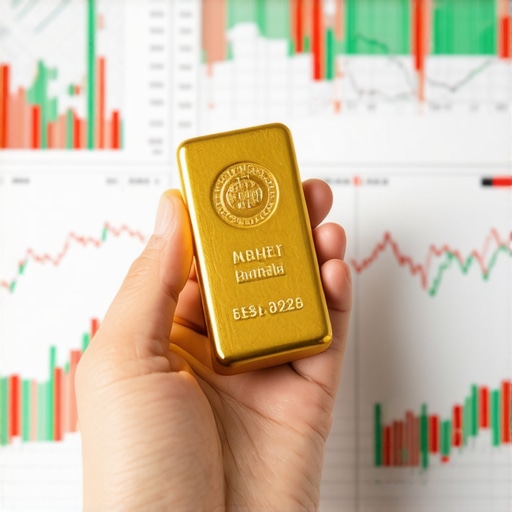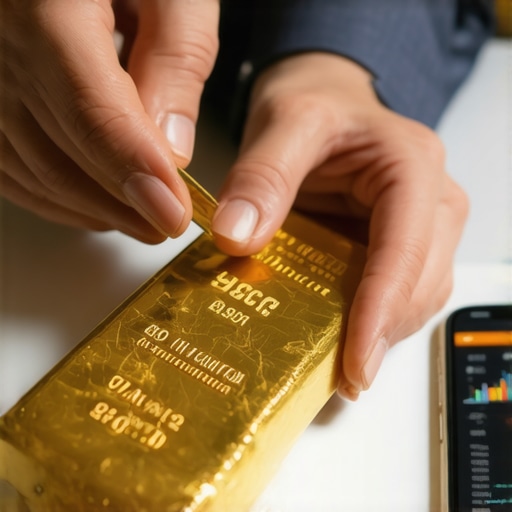Understanding Gold Futures: A Primer for New Investors
As the global economy continues to fluctuate, many investors are turning to gold as a stable investment option. For beginners, understanding the intricacies of investing in gold futures can be daunting, yet it offers a unique opportunity to capitalize on the rising value of this precious metal. This guide aims to break down the fundamentals of gold futures, helping you navigate this complex market with confidence.
What Are Gold Futures?
Gold futures are contracts that allow investors to buy or sell gold at a predetermined price at a specified date in the future. This trading mechanism not only helps investors hedge against fluctuations in gold prices but also allows them to speculate on future price movements. The appeal of gold futures lies in their potential for high returns, especially in times of economic uncertainty. If you’re considering diving into gold futures, it’s essential to understand the risks and rewards associated with this investment strategy.
Why Consider Gold Futures?
Investing in gold futures offers several advantages:
- Leverage: Futures contracts typically require a smaller initial investment compared to purchasing physical gold. This leverage can amplify your potential gains.
- Hedging: Investors often use futures contracts to protect their portfolios against the volatility of the gold market. By locking in prices, you can manage investment risks effectively.
- Liquidity: Gold futures are traded on major exchanges, providing high liquidity. This makes it easier to enter and exit positions as market conditions change.
Key Considerations Before Investing
Before you begin trading gold futures, it’s crucial to consider several factors:
- Market Knowledge: Familiarize yourself with the gold market and its influencing factors, such as geopolitical events and economic indicators. Staying informed can help you make better investment decisions.
- Trading Strategies: Develop a solid trading strategy. Whether you prefer day trading or long-term investments, having a clear plan will guide your actions and reduce emotional decision-making.
- Risk Management: Understand your risk tolerance. Futures trading can be volatile, and it’s essential to set stop-loss orders to protect your investment.
Getting Started with Gold Futures
To start investing in gold futures, you will need to open a brokerage account that supports futures trading. Many online brokers offer this service, allowing you to trade from the comfort of your home. After setting up your account, you can begin researching the current market trends and identifying potential opportunities.
For beginners, it’s also wise to consider working with a financial advisor who specializes in commodities and futures. Their expertise can help you navigate the complexities of the market and tailor an investment strategy that aligns with your financial goals.
As you dive deeper into the world of gold futures, remember that knowledge is power. The more you learn about market dynamics, trading strategies, and risk management, the better equipped you will be to make informed investment decisions.
Essential Strategies for Trading Gold Futures
As you embark on your journey into the world of gold futures trading, developing a clear strategy is vital. The gold market can be unpredictable, and having a well-defined approach can help mitigate risks and maximize profits. This section delves into key trading strategies that beginners should consider when trading gold futures.
Technical Analysis: Understanding Market Trends
Technical analysis is a crucial skill for successful trading in gold futures. This approach involves analyzing price charts and patterns to forecast future price movements. By studying historical price data, traders can identify trends and potential turning points in the market. Tools such as moving averages, Relative Strength Index (RSI), and Fibonacci retracement levels can provide insights into market momentum and help you make informed decisions. For a comprehensive understanding of market behavior, you may want to explore current trends in gold market analysis.
Fundamental Analysis: Monitoring Economic Indicators
In addition to technical analysis, fundamental analysis plays a pivotal role in gold trading. This method focuses on understanding the underlying factors that influence gold prices, such as economic data releases, interest rates, and global geopolitical events. For instance, rising inflation or economic instability often leads to increased demand for gold as a safe haven. Keeping track of reports on gold demand trends and economic indicators is essential for making educated investment choices. You can gain more insights by reading about gold demand trends in the current economic landscape.
Using Stop-Loss Orders to Manage Risk
Risk management is a critical component of successful trading. One effective technique is the use of stop-loss orders. A stop-loss order automatically sells your gold futures contract when the price reaches a predetermined level, helping to limit potential losses. Setting appropriate stop-loss levels requires careful consideration of market volatility and your risk tolerance. This strategy can provide peace of mind and ensure that you are not overly exposed to market fluctuations.
Practicing with a Demo Account
Before diving into live trading, consider practicing with a demo account. Many brokers offer this service, allowing you to trade with virtual funds while gaining valuable experience. A demo account enables you to test your strategies, understand trading platforms, and familiarize yourself with market dynamics without financial risk. This hands-on experience is invaluable for building confidence and enhancing your skills.
Staying Updated: Continuous Learning and Market Awareness
In the ever-changing landscape of gold futures, staying informed is paramount. Subscribing to market news, following expert analyses, and participating in trading forums can provide you with up-to-date information and diverse perspectives. Resources such as gold price analysis can offer valuable insights into current market conditions and future expectations.
As you refine your trading strategies, remember that patience and discipline are key. The journey into gold futures trading is filled with learning opportunities, and each experience can contribute to your overall understanding of the market. With the right strategies and a commitment to continuous improvement, you can navigate the complexities of gold futures with confidence.
Exploring Advanced Trading Techniques for Gold Futures
As you gain experience in gold futures trading, it’s essential to explore advanced strategies that can enhance your investment outcomes. These techniques can provide greater insights into market movements and help you capitalize on fluctuations in gold prices.
Options Trading: A Flexible Approach
One advanced strategy to consider is options trading on gold futures. Options give you the right, but not the obligation, to buy or sell a futures contract at a predetermined price before a specific date. This flexibility allows you to benefit from price movements while limiting potential losses. By employing strategies such as covered calls or protective puts, you can create a more sophisticated trading plan. For a deep dive into how options can complement your gold trading approach, check out strategies to optimize your portfolio.
Understanding Market Sentiment: The Role of News and Events
Market sentiment plays a vital role in gold price fluctuations. Monitoring news and geopolitical events can provide valuable insights into how the market may react. For instance, announcements regarding interest rate changes or economic data can significantly influence investor confidence and, consequently, gold prices. Staying updated on global economic indicators and their implications on gold price analysis can help you make timely trading decisions.
Utilizing Leverage Wisely: Enhancing Potential Gains
Leverage is a double-edged sword in gold futures trading; while it can amplify profits, it also increases potential losses. Understanding how to use leverage wisely is crucial. For example, consider adjusting your position sizes based on market conditions and your risk tolerance. This approach helps to balance your exposure and can protect your capital during volatile market periods.
Implementing Automated Trading Systems
Another powerful tool in modern trading is the use of automated trading systems. These systems can execute trades based on predefined criteria, allowing for quicker responses to market changes. By programming specific strategies into these systems, you can take advantage of price movements without constant monitoring. However, it’s essential to backtest your trading algorithms to ensure they perform well under various market conditions.
Continuous Learning: Staying Ahead in Gold Futures Trading
The landscape of gold futures is constantly evolving, and continuous learning is key to staying competitive. Participate in webinars, read market reports, and engage with online trading communities to gather new insights and strategies. Moreover, consider studying current trends in gold market analysis to refine your understanding of the market.
As you adopt these advanced strategies, remember that patience and discipline are crucial. Building expertise in gold futures trading takes time and practice, but with dedication, you can enhance your investment proficiency.
Analyzing Impactful Pricing Strategies in Gold Futures
Understanding pricing strategies is essential for maximizing returns in gold futures trading. By analyzing different pricing models, you can make informed decisions that align with your investment goals.
Exploring the intricacies of pricing strategies, such as the cost of carry model or the impact of seasonal trends, can provide insights into market dynamics. Look into how factors like supply and demand, geopolitical tensions, and inflation rates contribute to fluctuations in gold prices. By keeping abreast of these elements, you can better anticipate market movements and adjust your trading strategies accordingly.
Analyzing Impactful Pricing Strategies in Gold Futures
Understanding pricing strategies is essential for maximizing returns in gold futures trading. By analyzing different pricing models, you can make informed decisions that align with your investment goals. This section explores several impactful pricing strategies that can enhance your trading approach.
The Cost of Carry Model: A Key Pricing Strategy
The cost of carry model is a fundamental concept in futures trading, particularly for commodities like gold. This model considers the expenses associated with holding a position over time, including storage costs, insurance, and financing. When trading gold futures, understanding the cost of carry can help you determine the fair value of a futures contract compared to spot prices. For a deeper look into pricing strategies, you may want to explore gold price analysis which outlines the various influences on market pricing.
Seasonal Trends and Their Impact on Prices
Another critical component of pricing strategies is recognizing seasonal trends in the gold market. Historically, gold prices can fluctuate based on seasonal demand patterns, such as increased buying during wedding seasons in certain cultures or economic uncertainty during specific times of the year. By incorporating seasonal analysis into your trading strategy, you can plan your entries and exits more strategically. Monitoring these trends is vital for anticipating shifts in market dynamics and optimizing your trading approach.
Supply and Demand Dynamics: The Core of Pricing
At the heart of any pricing strategy lies the law of supply and demand. In the gold market, factors such as mining outputs, central bank purchases, and geopolitical tensions can significantly influence supply and demand dynamics. Understanding these factors allows traders to gauge potential price movements accurately. For instance, if a major gold-producing country faces political instability, the supply of gold may decrease, leading to higher prices. To further understand these dynamics, you can read about key factors influencing gold demand trends.
Inflation and Its Role in Gold Pricing
Gold is often viewed as a hedge against inflation; thus, inflation rates can have a profound effect on gold prices. When inflation rises, the purchasing power of currency declines, driving investors towards gold to preserve their wealth. Monitoring inflation indicators and economic forecasts can provide insights into potential gold price movements. For a comprehensive overview of how inflation impacts gold investments, consider reading key tips for investing in gold.
Incorporating Pricing Strategies into Your Trading Plan
To effectively incorporate these pricing strategies into your trading plan, it’s essential to adopt a systematic approach. Start by conducting thorough market research and analysis to understand current conditions. Develop a clear trading strategy that includes entry and exit points based on your pricing analysis. Utilizing tools such as technical indicators and fundamental analysis can further enhance your decision-making process. Remember, successful trading in gold futures requires adaptability and a willingness to continuously refine your strategies based on market feedback.
As you navigate the complexities of gold futures trading, remember that knowledge and strategic planning are your best allies. By mastering impactful pricing strategies, you can position yourself to capitalize on market movements and achieve your investment objectives.
Frequently Asked Questions About Gold Futures Trading
What are gold futures and how do they work?
Gold futures are contracts to buy or sell a specific amount of gold at a predetermined price on a set date in the future. They allow investors to speculate on the price movements of gold or hedge against risks in their portfolios.
Why should I invest in gold futures?
Investing in gold futures can provide benefits such as leverage, liquidity, and the ability to hedge against market volatility. Additionally, gold is often considered a safe-haven asset during economic downturns, making it appealing for diversifying your investment portfolio.
What risks are associated with trading gold futures?
The primary risks of trading gold futures include market volatility, leverage risk, and the potential for significant losses. It’s crucial for traders to understand their risk tolerance and implement risk management strategies, such as stop-loss orders.
How do I choose a brokerage for trading gold futures?
When selecting a brokerage for trading gold futures, consider factors such as fees, available trading platforms, customer support, and educational resources. Look for brokers that specialize in futures trading and offer a range of tools to help you succeed.
What are some effective strategies for trading gold futures?
Effective strategies include technical analysis to identify market trends, fundamental analysis to understand economic indicators, and practicing with demo accounts. Advanced techniques like options trading and automated trading systems can also enhance your trading approach.
How can I stay informed about the gold market?
Staying informed about the gold market involves subscribing to financial news outlets, following expert analyses, and participating in trading forums. Engaging with reputable sources can provide valuable insights and help you make informed trading decisions.
Is it necessary to have prior experience to trade gold futures?
While prior experience can be beneficial, it is not strictly necessary. Beginners can start with educational resources, demo accounts, and by working with financial advisors to build their understanding before engaging in live trading.
What tools can help me in gold futures trading?
Useful tools for gold futures trading include charting software for technical analysis, economic calendars for tracking important data releases, and trading platforms that offer real-time market data and alerts.
Authority Resources for Gold Futures Trading
For those looking to deepen their knowledge and understanding of gold futures trading, the following resources are highly recommended:
- CME Group – Futures Education: A comprehensive resource on futures trading, including educational articles and training programs.
- Investopedia – Gold Futures: An informative overview of gold futures, including definitions, trading strategies, and market insights.
- Kitco – Gold Market News: A trusted source for real-time gold market news, price charts, and analysis.
- Bloomberg – Financial News: Provides up-to-date financial news, including market trends and economic indicators affecting gold prices.
- World Gold Council: Offers research and insights on gold demand trends and market dynamics.
Conclusion: Navigating the World of Gold Futures
In conclusion, trading gold futures represents a compelling opportunity for investors looking to capitalize on the dynamics of the gold market. With a clear understanding of the strategies, risks, and resources available, you can confidently navigate this complex landscape. Whether you are a beginner or an experienced trader, continuous learning and strategic planning are essential for success. By leveraging the insights and techniques discussed in this guide, you can enhance your trading proficiency and achieve your investment objectives in the world of gold futures.










